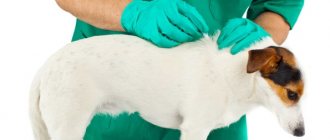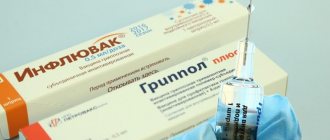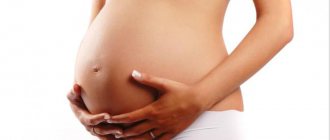Whooping cough
The incubation period for whooping cough can last from 3 days to two weeks. The disease occurs with a successive change of the following periods: catarrhal, spasmodic cough and resolution. The catarrhal period begins gradually, a moderate dry cough and runny nose appear (in children, rhinorrhea can be quite pronounced). Rhinitis is accompanied by a viscous, mucous discharge. Intoxication and fever are usually absent, body temperature can rise to subfebrile levels, and patients consider their general condition to be satisfactory. Over time, the cough becomes frequent and persistent, and attacks may occur (especially at night). This period can last from several days to two weeks. In children it is usually short-lived.
Gradually, the catarrhal period turns into a period of spasmodic cough (otherwise - convulsive cough). Coughing attacks become more frequent, more intense, and the cough becomes convulsive and spastic in nature. Patients may notice warning signs of an attack - a sore throat, chest discomfort, anxiety. Due to spastic narrowing of the glottis, a whistling sound (reprise) is noted before inhalation. A coughing attack is an alternation of such whistling breaths and, in fact, coughing shocks. The severity of whooping cough is determined by the frequency and duration of coughing attacks.
Attacks become more frequent at night and in the morning. Frequent stress causes the patient's face to become hyperemic and swollen, and minor hemorrhages may be observed on the skin of the face and mucous membrane of the oropharynx and conjunctiva. Body temperature remains within normal limits. Fever with whooping cough is a sign of a secondary infection.
The period of spasmodic cough lasts from three weeks to a month, after which the disease enters the recovery (resolution) phase: when coughing, mucous sputum begins to be coughed up, attacks become less frequent, lose their spasmodic nature and gradually stop. The duration of the resolution period can take from several days to several months (despite the subsidence of the main symptoms, nervous excitability, coughing and general asthenia can be observed in patients for a long time).
An erased form of whooping cough is sometimes observed in vaccinated individuals. In this case, spasmodic attacks are less pronounced, but the cough may be longer and more difficult to treat. There are no reprises, vomiting, or vascular spasms. The subclinical form is sometimes found in the focus of pertussis infection when examining contact persons. Subjectively, patients do not note any pathological symptoms, but a periodic cough can often be noted. The abortive form is characterized by the cessation of the disease at the stage of catarrhal signs or in the first days of the convulsive period and rapid regression of the clinic.
Whooping cough symptoms
The latent period can last 1-3 weeks, depending on the infecting dose and the condition of the child. During this period, infected children are not infectious to others.
The course of pertussis infection can be divided into 3 periods:
- catarrhal (1-2 weeks);
- paroxysmal period (2-4 weeks);
- recovery (1-2 months on average).
How dangerous is whooping cough and how to recognize it?
He walks across the country
In 2021, the incidence of whooping cough has increased in Russia. Over six months, there were 5,752 cases of this disease, which is 1.6 times more than the same period from 2006-2015. These figures are provided by izvestia.ru. But in fact, the number of cases is much greater than the number registered. Why? More on this below.
Experts cite three main reasons for the spread of whooping cough: the natural increase in incidence, which occurs with a certain periodicity, the population’s refusal to vaccinate and revaccinate, as well as low-quality vaccine on the market. The latter argument is difficult to prove, but nevertheless, on September 19 of this year, a batch of DTP vaccine was seized. The substandard drugs were identified by the branch of Roszdravnadzor in the Krasnoyarsk Territory.
For a mother whose baby is sick and coughs a lot, it is not very important for what reason this happened. It is much more important to recognize a dangerous disease at an early stage, especially if the child is under one year old. It is in this age category that the highest number of deaths occurs. Children simply suffocate, because babies cannot clear their throat and after three or four attempts they may stop breathing.
__________________________________________
In the DPT vaccine, it is the pertussis component that is most difficult to tolerate by the child’s body and therefore many mothers refuse vaccination, but it is important to remember that the susceptibility of unvaccinated children to whooping cough is 100%.
__________________________________________
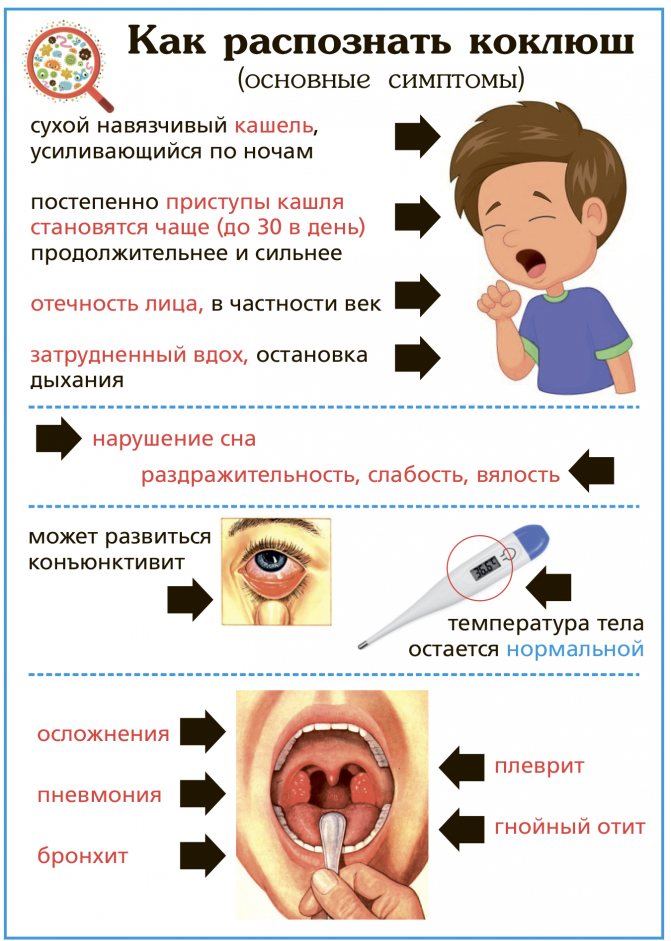
__________________________________________
Every year, about 60 million people fall ill with whooping cough, of which more than 300,000 (primarily babies under one year old) die.
__________________________________________
Why ARVI?!
Natalya TSUPILO, infectious disease doctor of the second category, head of the infectious diseases department of the Central City Hospital of Bataysk:
–
The main symptom of whooping cough is a prolonged cough with viscous sputum.
The cough torments all day, but especially severe attacks occur at night, closer to the morning. This condition can last up to three weeks, and the cough can persist for up to six months. But generally it lasts 2-3 months. The incubation period lasts up to 10 days. In the first two weeks, the child is especially contagious to others. It is noteworthy that with this disease there is no temperature or it is low-grade (37-37.2). Sometimes it goes up to 38, but it goes down easily. There is no snot with whooping cough either. But given that a person has been sick for a long time and his body is weakened, whooping cough can be layered with a secondary infection.
If your child has a severe cough, sometimes to the point of vomiting, and cannot take a full breath, call an ambulance immediately. In addition, a drop in blood pressure and convulsions are possible. Open a window, provide fresh air, turn on a humidifier, or even better, give your child inhalations with saline solution. These first aid methods will help ease the attack and wait for the emergency room. Remember that self-medication of whooping cough is deadly, especially if the child is in the first year of life.
Whooping cough is a bacterial infection and is treated with antibiotics, which work most effectively if started in the first week of illness. Then treatment is symptomatic: antitussives, inhalations, etc. All medications are prescribed by a doctor!
The disease is most often diagnosed based on clinical signs.
In order for the discharge to include “whooping cough,” the diagnosis must be confirmed by laboratory testing. To do this, it is necessary to conduct a double analysis of venous blood: drawing blood, sending it to the laboratory, and re-taking it two weeks later. Few mothers consent to such manipulations. Whooping cough is not diagnosed based on a general blood test. But in the presence of a characteristic cough, high values of leukocytes will indicate it. That is, if the doctor says that you have whooping cough, offers to undergo all the necessary tests and go to the hospital, but you refuse this, then the discharge will most likely indicate ARVI .
Is it possible to protect yourself and your children from whooping cough? Yes. For these purposes, DTP vaccination and revaccination are carried out, according to the national vaccination calendar. No, vaccination will not give you a 100% guarantee that you will not get infected. But the disease will progress much easier.
__________________________________________
The infection is transmitted by airborne droplets, but dies in the external environment. You can only get sick if the whooping cough bacillus gets directly into the trachea or bronchi, that is, if you inhale it.
__________________________________________
Don't treat your cough yourself
The disease causes many types and subtypes of cough, and each of them will have its own treatment methods
Common people divide coughs into dry and wet. When self-medicating, we are usually guided by the recommendations of the pharmacist at the nearest pharmacy or by our own experience. But this approach will only delay the recovery process and increase the cost of medications.
To evaluate a cough in all respects, you need to determine its character, timbre, rhythm, when it starts bothering you and how long it lasts. If it seems like all these are small things, you are wrong. A correct description of the type of cough can greatly facilitate the doctor’s search for pathology, which means it will speed up the correct diagnosis and the prescription of appropriate treatment.
So, if the cough lasts more than three weeks, then it is chronic, and before that moment it is acute. The cough can be constant, episodic, paroxysmal or short-term, as well as dry, wet, hoarse, barking, etc.
It happens that you cough, but do not experience relief. This cough is called non-productive. If you clear your throat, you help the body get rid of harmful substances, which means your cough is productive.
So, if you have ARVI or flu
, then the cough turns from dry to wet. Clear sputum indicates a viral infection, while purulent sputum means the infection is bacterial.
For laryngitis
the cough is painful, dry, and the voice is hoarse.
With pharyngitis
- severe soreness, tingling or pain in the throat, which forces the patient to cough to get rid of the feeling of a lump stuck in the throat.
For pneumonia
The cough is dry at first, and then becomes wet and paroxysmal. It’s interesting, but by the color of the sputum, experts can determine which infection led to pneumonia.
With pleurisy
The cough is dry, a stabbing pain appears in the chest, which intensifies with coughing and deep breathing.
For bronchial asthma
Chronic cough, shortness of breath, wheezing. During attacks, viscous sputum is released.
For sinusitis, sinusitis, vasomotor and allergic rhinitis
cough occurs due to mucus flowing down the back wall, which enters the trachea. Frequent coughing occurs, especially at night.
It can be idiopathic
dry cough, the cause of which cannot be determined even after thorough examinations. Most often it affects women during menopause.
As you can see, cough accompanies many diseases. To get rid of it or at least improve the quality of life, you should not self-medicate, because there is no general recipe. Only a doctor can make a diagnosis and prescribe treatment based on clinical symptoms, laboratory tests and other types of research.
Features of whooping cough in vaccinated people
When whooping cough occurs in vaccinated children, the symptoms are not so pronounced. The temperature may remain normal or rise slightly. General health does not suffer, appetite is good. Most often, the disease is never diagnosed and occurs under the guise of an acute respiratory infection.
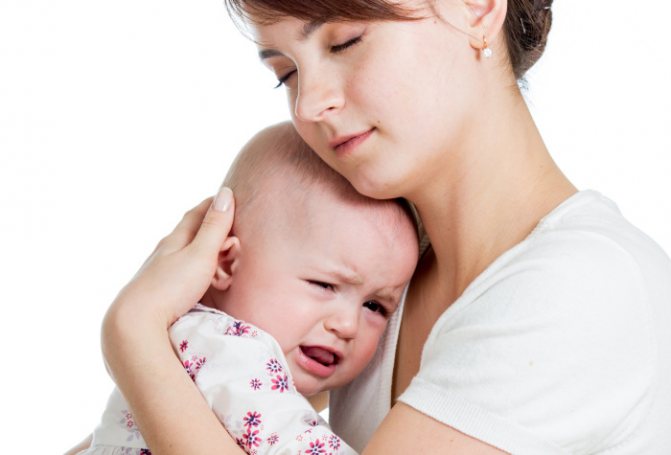
Whooping cough in previously vaccinated children can occur in an erased form, when the manifestation of the disease is a prolonged cough without attacks.
Even if coughing attacks appear, they are not long-lasting, occurring up to 7-10 times a day. During a coughing attack, no repetitions appear, which makes it difficult to diagnose whooping cough. The duration of cough during the recovery period is also shorter in vaccinated people.
Vaccination against whooping cough
A course of vaccination against whooping cough consists of several vaccinations that are given at certain periods of the child’s life. The first vaccination is given to children at three months of age, the second at 4.5 months, and the third at six months. At one and a half years old, a child who has received the first three vaccinations on time is given the first revaccination.
In Russia, to prevent whooping cough, combined vaccines (DTP) are used, which protect the child from three infections at once: whooping cough, diphtheria and tetanus. Children at risk are vaccinated using the drug Pentaxim, which provides them with additional protection against polio and Haemophilus influenzae infection. The vaccines are compatible with other drugs, except for the BCG-M and BCG vaccines against tuberculosis.
Treatment of whooping cough in vaccinated children
Whooping cough in a vaccinated child is usually treated at home, as it is mild. There are no effective medications that can quickly relieve whooping cough. If the diagnosis is made in the catarrhal period, antibiotics (most often low-toxic Erythromycin) are prescribed in an age-appropriate dosage.

When diagnosed after 2 weeks, the use of antibiotics does not make sense, since the toxin has already accumulated, the disease mechanism has started, and the bacterium itself dies.
It is best to ensure that children stay in the fresh air near a body of water (coughing is less likely to occur in cold, damp air). Fresh, moist air must also be provided in the child’s room. To do this, wet cleaning of the room and airing is carried out several times a day, using special devices for humidification or placing containers with water and hanging wet sheets. The optimal temperature will be 16-200C with a humidity of 50%. Getting the baby interested in an interesting activity (construction set, new doll, cartoons, etc.) can help reduce stimulation of the cough center.
Vaccinated children can actually get whooping cough. But the value of vaccination is that it provides protection during the most dangerous period - in children under one year of age. There is no innate immunity. If a vaccinated child gets sick, the disease will be mild and will not cause dangerous complications that could cause the baby’s death. Parents should think carefully before writing a refusal to vaccinate their child.





